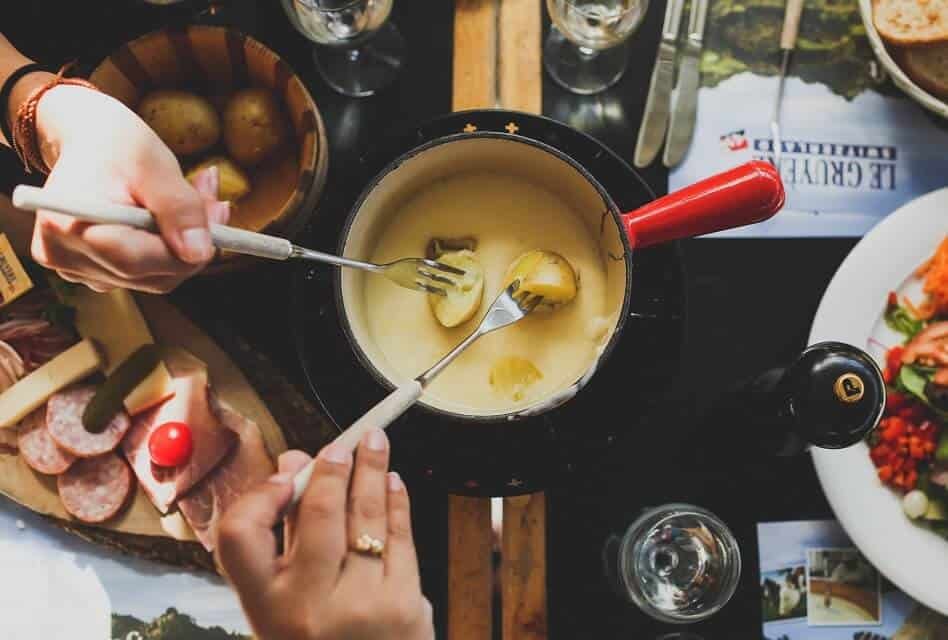Pork dishes are well-liked around the globe. Especially in Europe, you can find a wide variety of delicious meals. While beverages like beer might be the intuitive pairing for these meals, you definitely can create excellent pork and wine pairings as well. In this article, we will discuss the best of them:
- Pork Chops and Wine
- Tenderloin Pork and Wine
- Pork Schnitzel and Wine
- Pulled Pork and Wine
- Pork Casserole and Wine
- Pork Ribs and Wine
- Pork Goulash and Wine
- Pork Ham and Wine
- Pork Sausages and Wine
Before that, let us briefly discuss some general rules for pork and wine pairings.
WHAT DOES PORK MEAT TASTE LIKE?
>The flavor of pork meat strongly depends on the specific cut and the preparation method. Lean cuts, for instance, from the loin, are not very intense in flavor when unseasoned. They might remind you of poultry, although they have a denser structure. Cuts from the belly or the shoulder have more fat and thus also a more distinct intrinsic taste. It is not uncommon to sense a subtle sweetness in their richness. Nevertheless, they aren’t as intense as other types of meat, such as game or beef.
In most cases, the preparation method and the marinade or sauce used to season the meat are the dominant factors for flavor. Ham, for instance, is cured or smoked to prolong its shelf life. Logically, its predominant aromas include salty or smoky notes.
THE BASIC RULES FOR PAIRING PORK AND WINE
When choosing your wine pairing for pork dishes, the meat cut and its fat content are essential. But as the marinade and sauce are responsible for giving pork its flavors, you should consider them, too.
The following rules are good starting points for finding the best pork and wine pairings:
- Pork meals are usually on the rustic side and not particularly elegant. Thus, you should not open your most precious bottle to accompany them. Go for good quality but not a high-end wine.
- Most dishes work fine with light- to medium-bodied reds or medium- to full-bodied whites. There are exceptions, though.
- Dry wines are excellent for the majority of pork preparations. Sweet wines can be a good choice to create a contrast to meals with spicy or sour notes.
- If you serve your pork meal with a creamy sauce, you need a wine with a good level of acidity to cut through this creaminess. The same is true for fried pork dishes.
- Very spicy dishes are great with sparkling or semi-sparkling wines. They help clean your palate after each bite and thus reduce the spices’ heat.
- Wines that come from the same region as the meal often create the best pork and wine pairings. So if you prepare a traditional German meal, look for a bottle of German wine.
Based on these guidelines, you can find good wine pairings for most pork dishes. Nevertheless, let’s investigate some of the most popular meals and the matching wines in more detail.
Pork Chops and Wine
Pork chops belong to the most popular pork dishes. These cuts from the pork loin are lean, tender, and mild in flavor. They are easy to prepare, usually by grilling, broiling, or pan-roasting. Commonly, chefs season them with spices and herbs. In some cases, they brine the meat first to keep it moist and add some flavor.

Pork Chop with Vegetables
The best wine pairing depends more on the side dishes than the meat. And there are plenty of alternatives.
Pork chops are excellent with medium-bodied red wines when served with creamy herb or mushroom sauces. They should have a good level of acidity but only low levels of tannins. Try, for instance, Valpolicella wines. These DOC wines from Northern Italy are bold enough to stand the rich sauce but not too heavy to overpower the lean meat. Especially for barbecue garden parties, they are a perfect choice.
You can also try a Chianti:
- type: red, still, Vintage
- origin: Tuscany, Italy
- varietal: Sangiovese
- alcohol: 13.0%
- type: red, still, Vintage
- origin: Tuscany, Italy
- varietal: Sangiovese, Merlot
- alcohol: 13.5%
Santa Cristina by Antinori Chianti Superiore 2017
- type: red, still, Vintage
- origin: Tuscany, Italy
- varietal: Sangiovese
- alcohol: 13.0%
Another delicious creamy preparation is Pork Chops Dijonnaise. It comes from France, is prepared with spicy mustard and white wine, and is served with mashed potatoes and glazed onions. The mustard and the onions make this dish significantly spicier. Thus, you need to adjust the wine pairing: A New World rosé wine from Australia or New Zealand is the right pick. On the one hand, it has enough acidity to cut through the sauce. On the other hand, it has a good structure so that it will not be overwhelmed by the dish.
A side dish that might sound odd at first sight but is both common as well as delicious is apple sauce. To accompany the pork chops and this fruity add-on, open a red Côtes du Rhône Villages blend. As a white wine lover, pick an Old World Chardonnay, for instance, from France:
Joseph Drouhin Macon Villages 2019
- type: white, still, Vintage
- origin: Burgundy, France
- varietal: Chardonnay
- alcohol: 13.0%
Bouchard Pere & Fils Meursault (Domaine) 2017
- type: white, still, Vintage
- origin: Burgundy, France
- varietal: Chardonnay
- alcohol: 13.5%
Domaine Leflaive Puligny-Montrachet Les Pucelles Premier Cru 2018
- type: white, still, Vintage
- origin: Burgundy, France
- varietal: Chardonnay
- alcohol: 13.0%
A traditional meal from Germany features pork chops in red wine sauce with potato dumplings and red cabbage. This rich combination calls for a bold red wine. It should have a medium level of tannins to counter the sauce and the side dishes. A good choice is an Old World Cabernet Sauvignon:
Domaine Dozon Chinon Clos du Saut au Loup 2019
- type: red, still, Vintage
- origin: France, Loire Valley
- varietal: Cabernet Franc
- alcohol: 14.0%
Bernard Baudry Chinon La Croix Boissee 2018
- type: red, still, Vintage
- origin: France, Loire Valley
- varietal: Cabernet Franc
- alcohol: 13.0%
Thierry Germain Saumur Champigny La Marginale 2019
- type: red, still, Vintage
- origin: France, Loire Valley
- varietal: Cabernet Franc
- alcohol: 13.5%
Alternatively, go for a Cabernet-dominated left-bank blend from Bordeaux:
- type: red, still, Vintage
- origin: France, Bordeaux (left bank)
- varietal: Cabernet Franc, Cabernet Sauvignon, Merlot, Petit Verdot
- alcohol: 13.5%
- type: red, still, Vintage
- origin: France, Bordeaux (left bank)
- varietal: Cabernet Franc, Cabernet Sauvignon, Merlot, Petit Verdot
- alcohol: 14.0%
- type: red, still, Vintage
- origin: France, Bordeaux (left bank)
- varietal: Cabernet Sauvignon, Merlot
- alcohol: 13.0%
Tenderloin Pork and Wine
Tenderloin is the leanest pork cut. It comes from the animal’s back and typically has little to no fat at all. Nevertheless, it is juicy and full of flavor. The common ways to prepare tenderloin are grilling or roasting it after rubbing it with a simple mix of spices and herbs such as pepper, garlic, rosemary, thyme, basil, and oregano.
A lean pork cut like tenderloin offers many different wine options. Red wine lovers can pick a light- to medium-bodied wine like Pinot Noir, Grenache, or Cabernet Franc. These wines combine the delicious aromas of fruits and herbs. But they are not too intense and will not overpower the lean meat.
Joseph Drouhin Laforet Pinot Noir 2019
- type: red, still, Vintage
- origin: France, Burgundy
- varietal: Pinot Noir
- alcohol: 12.5%
Remoissenet Beaune Teurons Premier Cru 2019
- type: red, still, Vintage
- origin: France, Burgundy
- varietal: Pinot Noir
- alcohol: 14.0%
Domaine Comte Georges de Vogue Bonnes-Mares Grand Cru 2018
- type: red, still, Vintage
- origin: France, Burgundy
- varietal: Pinot Noir
- alcohol: 13.0%
If you prefer whites, there are plenty of matching wines for you, too. Your wine should have at least a medium body, though. Enjoy your pork Tenderloin with a French Sémillon or a Chenin-Blanc:
Domaine Huet Vouvray Sec Le Haut Lieu 2019
- type: white, still, Vintage
- origin: Loire, France
- varietal: Chenin Blanc
- alcohol: 13.0%
- type: white, still, Vintage
- origin: Loire, France
- varietal: Chenin Blanc
- alcohol: 13.0%
Domaine Huet Vouvray Le Mont Moelleux 2020
- type: white, still, Vintage
- origin: Loire, France
- varietal: Chenin Blanc
- alcohol: 13.0%
Pork Schnitzel and Wine
In Central Europe, one of the most popular pork preparations is schnitzel. The original “Wiener Schnitzel” is traditionally made from veal. But pork schnitzel is at least similarly loved, especially in Germany. The Germans use very thin cuts from the pig’s hind legs to make it. They season the meat with salt and pepper and roll it in flour, egg yolk, and bread crumbs. Next, they fry it in hot oil until the crust is golden-brown and crispy.

Pork Schnitzel with French Fries and Salad
A great wine to match the crispy schnitzel is a Grüner Veltliner from Austria. This white wine offers flavors of green and tropical fruits, herbs, and mild spices such as white pepper. Its high acidity is just right to cut through the meat’s crust and also through creamy sauces.
Alternatively, try a German Riesling Kabinett. These off-dry wines add some sweetness as well as fruity aromas to the meal’s flavors:
Weingut Alzinger Steinertal Smaragd Grüner Veltliner 2019
- type: white, still, Vintage
- origin: Austria, Wachau
- varietal: Grüner Veltliner
- alcohol: 13.5%
Pratsch Organic Grüner Veltliner 2020
- type: white, still, Vintage
- origin: Austria, Niederösterreich
- varietal: Grüner Veltliner
- alcohol: 12.5%
Schloss Gobelsburg Schlosskellerei Gobelsburger Grüner Veltliner 2020
- type: white, still, Vintage
- origin: Austria, Kamptal
- varietal: Grüner Veltliner
- alcohol: 12.5%
Dr. Loosen Wehlener Sonnenuhr Riesling Spätlese 2019
- type: white, still, Vintage
- origin: Germany, Mosel
- varietal: Riesling
- alcohol: 8.5%
Schloss Vollrads Rheingau Riesling Spätlese 2016
- type: white, still, Vintage
- origin: Germany, Rheingau
- varietal: Riesling
- alcohol: 7.5%
J.J. Prum Graacher Himmelreich Riesling Kabinett 2020
- type: white, still, Vintage
- origin: Germany, Mosel
- varietal: Riesling
- alcohol: 9.0%
Red wine lovers should pair their schnitzel with a New World Pinot Noir, for instance, from California:
Joseph Phelps Freestone Vineyards Pinot Noir 2019
- type: red, still, Vintage
- origin: United States, California
- varietal: Pinot Noir
- alcohol: 14.0%
Belle Glos Las Alturas Vineyard Pinot Noir 2019
- type: red, still, Vintage
- origin: United States, California
- varietal: Pinot Noir
- alcohol: 15.0%
DuMOL Wester Reach Pinot Noir 2019
- type: red, still, Vintage
- origin: United States, California
- varietal: Pinot Noir
- alcohol: 14.0%
Pulled Pork and Wine
Pulled pork is a delicious dish that American barbecue lovers surely know and love. It is usually a shoulder cut that undergoes a preparation method known as low-and-slow cooking. The meat is rubbed with a marinade of various spices and then cooked or smoked at relatively low temperatures of 200 to 260°F (100-130°C). During cooking, which can take between 10 and 15 hours, the chef regularly applies a spicy sauce to the meat, so it does not dry out. When ready for serving, the meat is so tender that it can be pulled apart easily.
After hours of cooking, pulled pork has a rich, smoky flavor profile. Depending on the marinades, they can feature sweet, fruity, herbal, or spicy notes. Often, it comes with a BBQ dip that adds even more spiciness.
The right wine pairing for pulled pork is red with a full body and a good level of acidity. Fruity wines like Italian Primitivo or Negroamaro wines are perfect, primarily if your marinade or sauce features fruity notes.
- type: red, still, Vintage
- origin: Puglia, Italy
- varietal: Primitivo
- alcohol: 14.0%
Cantine San Marzano Anniversario 62 Primitivo di Manduria Riserva 2018
- type: red, still, Vintage
- origin: Puglia, Italy
- varietal: Primitivo
- alcohol: 14.5%
Leone de Castris Il Medaglione Primitivo 2018
- type: red, still, Vintage
- origin: Puglia, Italy
- varietal: Primitivo
- alcohol: 13.5%
- type: red, still, Vintage
- origin: Puglia, Italy
- varietal: Malvasia Nera, Negroamaro
- alcohol: 14.0%
Li Veli Passamante Salice Salentino Negroamaro 2019
- type: red, still, Vintage
- origin: Puglia, Italy
- varietal: Negroamaro
- alcohol: 13.5%
If your pork is very spicy, consider Zinfandel wines from California. They typically have complementing spicy flavors and are a delicious match.
Seghesio Sonoma Zinfandel 2019
- type: red, still, Vintage
- origin: United States, California
- varietal: Zinfandel
- alcohol: 15.0%
Rombauer El Dorado Twin Rivers Zinfandel 2019
- type: red, still, Vintage
- origin: United States, California
- varietal: Zinfandel
- alcohol: 16.0%
Hartford Russian River Old Vine Zinfandel 2019
- type: red, still, Vintage
- origin: United States, California
- varietal: Zinfandel
- alcohol: 16.0%
Pork Casserole and Wine
As we are talking about slow cooking, let us discuss another fantastic meal: pork casserole. It takes less time to prepare than pulled pork, but nevertheless, you should plan 5 to 8 hours of cooking. The right meat for this dish comes from the shoulder. It is a heavy and fatty cut, but the extensive cooking in a slow cooker makes it so tender that it almost falls apart.
In Mediterranean countries, pork casserole simmers in a tomato-based broth with various vegetables such as carrots, leeks, onions, bell peppers, or olives. Together with salt, pepper, coriander, oregano, cumin, bay leaf, thyme, and a splash of red wine, it becomes a thick, hearty stew. Usually, it is served with boiled or mashed potatoes.
To match your pork casserole, pick the same whites that make a good tenderloin pairing, such as Chenin Blanc or unoaked Chardonnay (see the pork chops pairings).
Domaine Huet Vouvray Sec Le Haut Lieu 2019
- type: white, still, Vintage
- origin: Loire, France
- varietal: Chenin Blanc
- alcohol: 13.0%
- type: white, still, Vintage
- origin: Loire, France
- varietal: Chenin Blanc
- alcohol: 13.0%
Domaine Huet Vouvray Le Mont Moelleux 2020
- type: white, still, Vintage
- origin: Loire, France
- varietal: Chenin Blanc
- alcohol: 13.0%
In case you prefer red wines, choose one from the Côtes du Rhône appellation in France. These simple yet flavorful wines provide fruit aromas that complement the dish superbly. Other options include Tempranillo from the Navarra region in Spain and Malbec from Argentina.
Pork Ribs and Wine
Last but not least, we have to talk about pork ribs. Just like pulled pork or casserole, ribs belong to the slow-cooking dishes. They are marinated with a barbecue sauce and either grilled or baked in the oven. On the grill, they need between 60 and 120 minutes; in the oven, up to 4 hours. When done, the meat basically falls off the bones. It is deliciously tender, full of juicy flavors, and has sweet and spicy aromas from the marinade.
Although all ribs undergo the same preparation methods, it is important to distinguish two types that differ primarily in size and, thus, in cooking time:

Pork Ribs
- Spare ribs are the best-known variation. They come from the belly, contain a good amount of meat, and are somewhat fatty. The slow cooking at low temperatures renders the fat, though, so the meat is relatively lean and tender at serving time.
- Baby back ribs come from the pig’s loin (but not from baby pigs, as the name might suggest). They are shorter and curvier than spare ribs, with lean meat between them. Also, they are more expensive.
The best wine to pair with the juicy, sweet ribs meat is a red wine that is not too bold and relatively low in tannins. Especially young wines with intense fruit flavors are an excellent match. Go for a Grenache, a Merlot, or a Pinot Noir.
Bodegas Mas Alta La Basseta 2006
- type: red, still, Vintage
- origin: Spain, Priorat
- varietal: Carignan, Garnacha, Merlot, Syrah
- alcohol: 14.5%
Bodegas Mas Alta Romani La Basseta 2017
- type: red, still, Vintage
- origin: Spain, Priorat
- varietal: Cabernet Sauvignon, Carignan, Garnacha
- alcohol: 14.5%
Clos Figueres Font de la Figuera Priorat 2018
- type: red, still, Vintage
- origin: Spain, Priorat
- varietal: Cabernet Sauvignon, Carignan, Garnacha, Monastrell, Syrah
- alcohol: 15.0%
White wine can be an interesting add-on as well. It needs a good level of acidity and, ideally, aromas of green fruits. Try a dry Pinot Grigio, a Semillon, or an Old World Chardonnay.
Domaines Schlumberger Spiegel Grand Cru 2018
- type: white, still, sweet, Vintage
- origin: France, Alsace
- varietal: Pinot Gris
- alcohol: 13.5%
Albert Boxler Sommerberg Wibtal 2016
- type: white, still, off-dry, Vintage
- origin: France, Alsace
- varietal: Pinot Gris
- alcohol: 14.0%
- type: white, still, off-dry, Vintage
- origin: France, Alsace
- varietal: Pinot Gris
- alcohol: 13.5%
When marinated with very spicy sauces, you can pick a Moscato d’Asti. The sweet sparkler from Italy complements the meat’s flavors deliciously while tuning down its heat. Here are three examples:
- type: white, semi-sparkling, Vintage
- origin: Piedmont, Italy
- varietal: Muscat
- alcohol: 5.0%
La Morandina Moscato d’Asti 2021
- type: white, semi-sparkling, Vintage
- origin: Piedmont, Italy
- varietal: Muscat
- alcohol: 5.5%
Cantine Elvio Tintero Moscato d’Asti Sori Gramella 2021
- type: white, semi-sparkling, Vintage
- origin: Piedmont, Italy
- varietal: Muscat
- alcohol: 5.5%
Pork Goulash and Wine
The Hungarians know another delicious way to enjoy pork: goulash. It is fair to put this traditional stew in the slow-cooking category, too, because it typically takes around two hours to prepare. The main ingredients for this dish are meat, potatoes, carrots, bell peppers, and onions. They are simmered in a rich broth and seasoned with salt, black pepper, bay leaf, and plenty of Hungarian paprika. Paprika is made from dried or smoked peppers.
After long cooking, the meat is very tender, and the vegetables are very soft. Depending on the amount of broth, the meal can be thick, like a stew, or relatively thin, like a soup. In any case, the paprika mainly defines the goulash’s flavor profile. It can range from sweet and mild to very hot.
A great wine to enjoy with goulash is a bold red. Kékfrankos (also known as Blaufränkisch) from the Sopron region in Southern Hungary is the perfect regional match. It comes with aromas of ripe black fruits and earthy as well as floral notes. A Spanish Rioja matches the paprika-seasoned dish excellently, too:
La Rioja Alta Gran Reserva 904 Tinto 2011
- type: red, still, Vintage
- origin: Spain, Rioja
- varietal: Tempranillo
- alcohol: 13.5%
La Rioja Alta Vina Ardanza Reserva 2012
- type: red, still, Vintage
- origin: Spain, Rioja
- varietal: Tempranillo
- alcohol: 14.5%
Torre de Ona by La Rioja Alta Reserva Finca Martelo 2014
- type: red, still, Vintage
- origin: Spain, Rioja
- varietal: Mazuelo, Tempranillo
- alcohol: 14.5%
Pork Ham and Wine
Ham is a popular dish for Christmas but also for many other occasions. You can enjoy it cold or warm, as a main dish or a starter course, and with or without side dishes. While you can eat ham fresh, it’s more common to find salted, smoked, or wet-cured variations that keep longer but are equally delicious.
Pork ham has a fleshy density and is rather low in fat. It is typically salty but also has subtle sweet notes. When roasted, ham usually gets a glaze that imparts additional aromas, which can be sweet, savory, or spicy.
The perfect wine pairing for your ham depends on the preparation method. When served cold without additional glazes and sauces, you should pick a light, dry white wine. Italian Pinot Grigio and dry German Riesling belong to this category:
Santa Margherita Pinot Grigio 2020
- type: white, still, dry, Vintage
- origin: Italy, Trentino-Alto Adige
- varietal: Pinot Gris
- alcohol: 12.5%
Tiefenbrunner Pinot Grigio 2019
- type: white, still, dry, Vintage
- origin: Italy, Trentino-Alto Adige
- varietal: Pinot Gris
- alcohol: 12.5%
- type: white, still, dry, Vintage
- origin: Italy, Friuli-Venezia Giulia
- varietal: Pinot Gris
- alcohol: 13.0%
Rebholz Von Rotliegenden Riesling Trocken 2020
- type: white, still, Vintage
- origin: Pfalz, Germany
- varietal: Riesling
- alcohol: 12.0%
Burklin-Wolf Pfalz Estate Riesling Trocken 2020
- type: white, still, Vintage
- origin: Pfalz, Germany
- varietal: Riesling
- alcohol: 12.0%
Von Winning Deidesheimer Paradiesgarten Riesling Erste Lage Trocken 2020
- type: white, still, Vintage
- origin: Pfalz, Germany
- varietal: Riesling
- alcohol: 12.0%
- type: white, still, Vintage
- origin: Alsace, France
- varietal: Gewürztraminer
- alcohol: 14.0%
Zind-Humbrecht Gewürztraminer 2019
- type: white, still, Vintage
- origin: Alsace, France
- varietal: Gewürztraminer
- alcohol: 14.0%
Albert Boxler Gewürztraminer Reserve 2018
- type: white, still, Vintage
- origin: Alsace, France
- varietal: Gewürztraminer
- alcohol: 14.0%
Pinot Noir is the right pairing for red wine lovers, particularly for roasted hams. It is not too heavy so that it will not overpower the ham, and it adds delicious fruity notes to the flavor profile. If the roast’s glaze is sweet, choose a New World wine, for instance, from California. An Old World Pinot Noir is better with more savory and spicy glazes. For very savory preparations, a Barolo from Italy is another great option.
Paolo Conterno Barolo Ginestra 2016
- type: red, still, Vintage
- origin: Italy, Piedmont
- varietal: Nebbiolo
- alcohol: 15.5%
Marchesi di Barolo Barolo Sarmassa 2014
- type: red, still, Vintage
- origin: Italy, Piedmont
- varietal: Nebbiolo
- alcohol: 14.5%
Cordero di Montezemolo Barolo Enrico VI 2015
- type: red, still, Vintage
- origin: Italy, Piedmont
- varietal: Nebbiolo
- alcohol: 15.0%
Pork Sausages and Wine

Bratwurst with Mustard and Potato Salad
Pork also comes in many different types of sausages. Again, the Germans have some delicious recipes to offer. The staple of German BBQ is the famous Bratwurst. It can be made from different types of meat, but pork is very common. The meat is seasoned with salt, pepper, and various herbs, including thyme, marjoram, garlic, or caraway, and scalded afterward. To make it ready for consumption, it has to spend a couple of minutes on the grill.
Bratwurst is spicy and full of flavor. And the typical side dishes such as Sauerkraut and mustard add even more intensity. This combination of sour, spicy, and herbal aromas works very well with dry, acidic white wines. Many regional wines, such as German Riesling or Grüner Veltliner from Austria, have precisely these characteristics.
Sparkling wine lovers can create a fascinating culinary experience. Combine your Bratwurst with a sweet sparkler such as Moscato d’Asti or Asti Spumante. The contrast between the sweet wine and the spicy and sour food is incredibly good.
- type: white, sparkling
- origin: Piedmont, Italy
- varietal: Muscat
- alcohol: 5.0%
- type: white, sparkling
- origin: Piedmont, Italy
- varietal: Muscat
- alcohol: 7.5%
- type: white, sparkling
- origin: Piedmont, Italy
- varietal: Muscat
- alcohol: 7.5%
If you want to try sparkling red wine, go for Lambrusco:
Cleto Chiarli Lambrusco Di Sorbara Vecchia Modena 2020
- type: red, sparkling, Vintage
- origin: Emilia-Romagna, Italy
- varietal: Lambrusco
- alcohol: 11.0%
- type: red, sparkling
- origin: Emilia-Romagna, Italy
- varietal: Lambrusco
- alcohol: 12.0%
Venturini Baldini Marchese Manodori Lambrusco
- type: red, sparkling
- origin: Emilia-Romagna, Italy
- varietal: Lambrusco
- alcohol: 12.0%
FINAL WORDS
Finding a good pork and wine pairing is not hard, and there are plenty of options to do so. With the examples from this article, you are well prepared to find your favorite wine and pork combinations. Enjoy!






